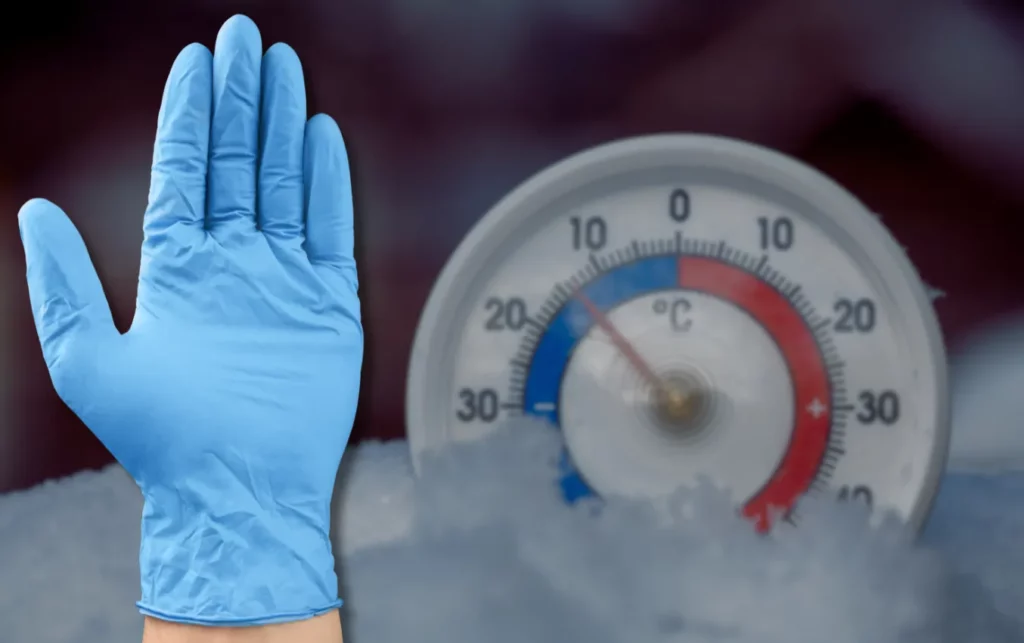Many industries rely on nitrile gloves for their chemical resistance and durability, but exposure to cold temperatures below 0°C can significantly impact their performance. Nitrile gloves become stiff, lose flexibility, decrease grip, and fail to provide insulation in freezing conditions. The temperature-dependent permeation rates of chemicals through nitrile gloves further highlight the importance of understanding how low temperatures affect their effectiveness. With insights on mechanical deformations, physiological solutions, and specific formulation considerations, it’s vital to ensure nitrile gloves are suitable for cold weather applications to maintain their protective capabilities.
Table of Contents
- Limitations of Nitrile Gloves in Cold Temperatures
- Potential for Cracking or Damage
- Inability to Provide Adequate Insulation
- Impact of Low Temperatures on Nitrile Gloves
- Temperature Dependence of Permeation Rates
- Mechanical Deformations and Physiological Solutions
- Effects of Low Temperatures on Nitrile Glove Performance
- Dependence on Formulation and Intended Application
- Related Posts
Limitations of Nitrile Gloves in Cold Temperatures
| Reduced Flexibility and Dexterity | Decreased Grip and Tactile Sensitivity |
| For reduced flexibility and dexterity in nitrile gloves at cold temperatures below 0°C, the nitrile material becomes stiff, impacting dexterity and grip. | The decreased grip and tactile sensitivity in nitrile gloves at low temperatures can hinder the wearer’s ability to handle objects efficiently. |
Potential for Cracking or Damage
On prolonged exposure to freezing, nitrile gloves may experience cracking or damage, compromising their protective function.
Dexterity can be significantly impacted when wearing nitrile gloves in cold temperatures, as the reduced grip and tactile sensitivity can make handling objects more challenging. Nitrile gloves are known for their chemical resistance, but in freezing conditions, they may not provide the necessary grip and dexterity required for various tasks, making them less effective in cold environments. Therefore, it is vital to use gloves specifically designed for low temperatures to ensure optimal performance.
Inability to Provide Adequate Insulation
Nitrile gloves are unable to provide sufficient insulation to keep hands warm in freezing conditions, making them less suitable for cold weather applications.
While nitrile gloves excel in chemical protection, their insulation properties are limited compared to other materials like PVC or insulated gloves. This limitation can lead to discomfort or even cold-related injuries when working in freezing temperatures. It is recommended to utilize gloves specifically designed for low temperatures, such as those with insulation, for enhanced warmth and protection in cold environments.
Impact of Low Temperatures on Nitrile Gloves
Temperature Dependence of Permeation Rates
| Temperature Dependence of Permeation Rates: | The permeation rates of chemicals through nitrile gloves increase with temperature, while breakthrough times decrease significantly as temperature rises from 25°C to 50°C. |
| Extrapolation to higher temperatures: | Extrapolation to higher temperatures (70°C and 93°C) shows even more drastic reductions in breakthrough times, indicating that higher temperatures severely compromise glove integrity. |
Temperature can significantly impact the permeation rates of chemicals through nitrile gloves, with a clear decrease in breakthrough times as temperature rises. This highlights the importance of understanding how temperature affects the performance of nitrile gloves in different working conditions.
Mechanical Deformations and Physiological Solutions
| Mechanical Deformations: | Mechanical deformations combined with exposure to physiological solutions significantly alter the mechanical properties of nitrile gloves. |
| Impact of Deformations: | The frequency and number of deformations impact the degree of crystallinity and surface deterioration, further affecting glove performance. |
With mechanical deformations and exposure to physiological solutions like sweat, nitrile gloves undergo significant changes in their mechanical properties. This highlights the need to consider these factors when assessing the effectiveness of nitrile gloves in various environmental conditions.
Effects of Low Temperatures on Nitrile Glove Performance
| Excessive Shrinkage of Rubber | Higher Probability of Developing a Leak Path |
| An excessive shrinkage of the rubber in nitrile gloves can occur when exposed to temperatures below their recommended operating range, potentially leading to a higher probability of developing a leak path in the gloves. | Performance of nitrile gloves in low temperatures can result in excessive shrinkage of the rubber, which may lead to a higher probability of developing a leak path. This can compromise the integrity of the gloves and reduce their effectiveness as a protective barrier. |
Dependence on Formulation and Intended Application
Probability of impurity contamination sources can vary based on the formulation and intended application of nitrile gloves. It is crucial to consult with the manufacturer or supplier to determine suitable temperature limits for specific glove use.
Rubber seal manufacturers can modify nitrile elastomers for lower temperature applications, ensuring the best performance in specific conditions. By incorporating the right level of low-temperature performance and fuel/oil resistance, they can optimize nitrile gloves for various applications, balancing cold temperature performance and chemical resistance.
To wrap up, it is evident that cold temperatures can significantly impact the performance of nitrile gloves, leading to reduced flexibility, decreased grip, and potential damage. Understanding the temperature limits of nitrile gloves is crucial for maintaining their effectiveness in various working conditions. Manufacturers can modify nitrile formulations to improve performance at lower temperatures, but careful consideration of application requirements is imperative. Consulting with manufacturers or suppliers to ensure the gloves are suitable for specific use cases is key. Summing up, being aware of the effects of cold temperatures on nitrile gloves is vital for selecting the most appropriate hand protection in challenging environments.






